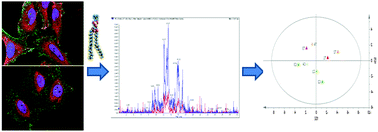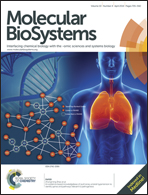A lipidomics investigation of the induced hypoxia stress on HeLa cells by using MS and NMR techniques
Abstract
Induced hypoxia stress on cervical cancer derived cells (HeLa cells) leads to significant changes in their membrane lipid profiles. The lipidome of HeLa cells was characterized by a joint approach wherein liquid chromatography-mass spectrometry (LC-MS) analysis was followed by high resolution NMR measurements. Multivariate data analysis showed apparent separation between control and hypoxia-treated HeLa cells and thus demonstrated hypoxia effects on lipid metabolism. The most striking finding was that hypoxia stimulation significantly reduced the total amount of cellular phosphoinositols (PI) but caused a prominent increase in the amount of lyso phosphocholines (lyso-PC) and lyso phosphoethanolamines (lyso-PE). The observed decrease of PI amount under hypoxic conditions is probably due to the accumulation of cellular myo-inositol, which is known to play a critical role in de novo synthesis of PI. Moreover, our study suggests that polyunsaturated phospholipid species are stronger biomarkers for discriminating the effect of hypoxia treatment. The evaluation of changes in the average unsaturation index (UI) of the membrane lipids acyl chains reveals that UI slightly increases in several lipid classes, thus affecting membrane fluidity and further membrane-dependent functions. The plausible mechanisms by which HeLa cells adapt to hypoxia conditions are also briefly reported.


 Please wait while we load your content...
Please wait while we load your content...